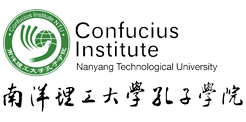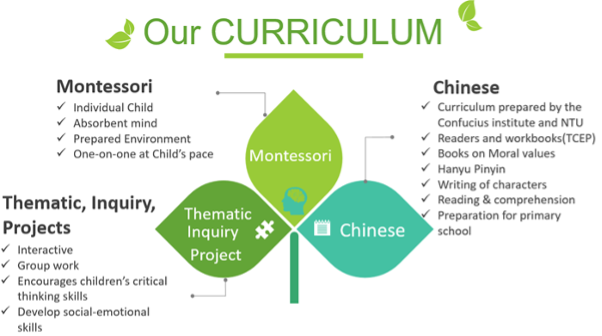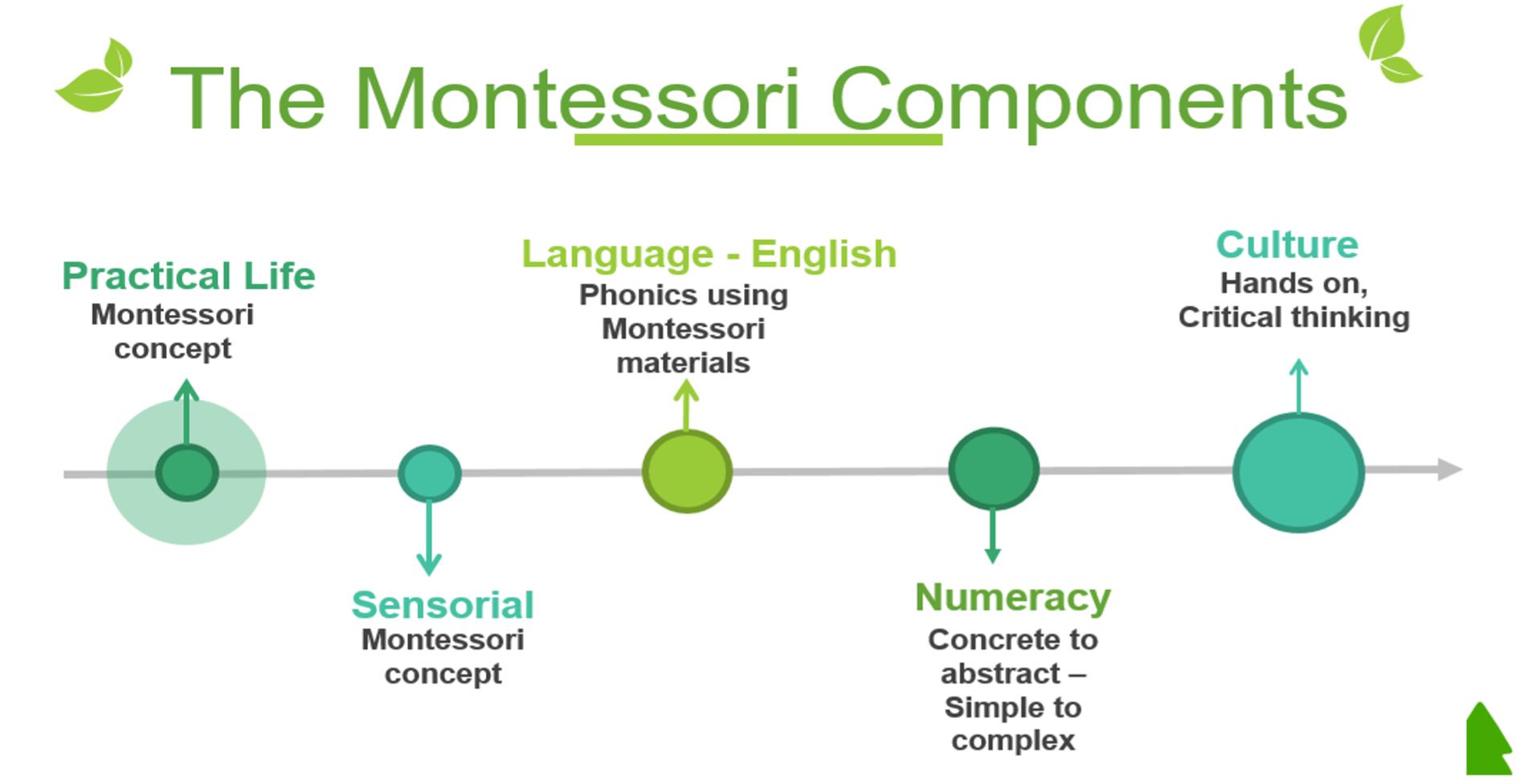
STRATEGIES FOR LEARNING
The more ways we learn something, in more situations, with more intelligences, more emotions, more forms of media, the more we will embed that learning” – Eric Jensen (1997)
Brained-Based Learning Principles
At Our Children’s House, we believe that children are individuals with innate abilities and learning styles. We also believe that we should cater their learning in accordance with their individual needs, as well as optimise their learning through the environment and strategies that we employ. Hence, we promote both an individualised Montessori programme as well as one that promotes group discussions and interaction. Scientific research shows that children learn better and have improved working memory through:
- Meaningful Learning; building on what they already know;
- Associations (pattern recognition and correlation) and Adaptability
- Compatibility (consistency and matching)
- Construal Level Spectrum (the abstract and concrete) for effective learning
- Variance and Feedback (extensions and learning from trial and error)
- Sensory Integration (Paivio’s dual-coding theory, multiple sensory integration)
- Transfer Effect (transfer of learning to another area of learning)
- Priming and Repetition
- Focused Attention and Physical Engagement (building concentration)
- Constructive Collaborative Learning (meaningful group activities and discussions)
- Fun and Engaging Environment (variety of stimuli and strategies and positive reinforcements and emotional well-being)
Bibliography
Bonomo, V. (2017). Brain-based learning theory. Journal of Education and Human Development, 6(1), 27-43.
Sadowski, S. (1995). Reinventing schools through brain-based learning. Educational Leadership.
Shukla, A., Aditya Shukla. (2021, September 15). Brain-Based Learning: Theory, strategies, and concepts. Cognition Today. Retrieved December 14, 2021, from https://cognitiontoday.com/brain-based-learning-theory-strategies-and-concepts/#Brain-Based_Learning_Theory.
OCH Themes, Projects, Inquiry-Based Programme
Based on the brain-based learning principles, the school organises lessons for the themes, projects, inquiry-based programmes in order to optimise the children’s learning and retention.
They are relatable to the children’s life’s experiences; including celebrations, about themselves and their families, friends, nature, and the world they live in. There are extensions in the themes each year to make learning fun and evolving. Some of the projects include the following activities.
Financial Literacy Programme (Project Based- N2 to K2)
Imparts values such as contentment, commitment, carefulness, consistency, confidence, compassion, charity, making sensible decisions, having a savings mind-set, prioritising between needs and wants, promotes healthy eating and habits, as well as learning not to waste things.
Achieved through age-appropriate lessons, books, games and role-play, all specially designed by pre-school practitioners and designed and researched by Dr Koh Noi Keng, Chair of the Citi-NIE Financial Literacy Hub for teachers.
Augmented by centre-based creative lessons with concrete materials and experiential learning for overall holistic approach to learning.
Objectives:
To ensure that the children will:
- learn how to make good judgments while decision making.
- learn to differentiate between needs and wants.
- understand the consequences of making an unwise decision.
- learn to develop good habits and a healthy lifestyle.
- understand the concept of money, it’s uses, and adding and subtracting.
- apply their learning in a concrete way.
- improve on their observations and writing skills.
- learn that their actions have consequences.
Science, Technology, Engineering, Art and Math (S.T.E.A.M)
Our children will be exposed to different programmes in relation to science, technology, engineering, art and mathematics. Using age appropriate, activities for the different levels (Tots to K2s), the children will explore them in relation to themes, and through projects/inquiry-based lessons. The children will learn how these activities apply in our daily lives. These will include, but not limited to:
S – understanding basic concepts of science. Includes botany, the human body, non-living and living things.
T- application of science to solve problems. Magnets, simple machines, compass, simple circuit boards, robotics and coding
E- building of things; including constructive blocks, lego, robots, bridges, cars
A– Understanding colours, textures, different genres of art; including fabric printing, resin craft, silk printing craft
M– understanding its application in daily life; length, weight, volume, height, temperature. Cookery, baking, practical life activities.
Sustainability Programmes
In line with the global efforts to promote sustainability and eco-friendly practices, the school will engage children in:
- “Grow Your Own Food” programme through Hydroponics and outdoor planting of edible food
- Reducing, Reusing and Recycling activities and lessons.
OCH First Steps Music and Movement
Children will learn different rhymes, rhythm and songs using a variety of instruments and understanding their names. They will also gain basic understanding of the notes on the piano and exposure to it.
They will enjoy a plethora of songs, including:- Action songs, song tales, call and response songs, echo songs and beat motion lessons. These activities will hone their senses, pitch, tone and rhythm, which are integral language learning, and in their overall development.
Cookery and Baking programmes
Our children will be exposed to a variety of cooking and baking activities, and to role play in their chef’s clothes. They will also explore mathematical concepts in these activities (eg. volume, measurements, weight) as well as vocabulary on the utensils, ingredients and tools used.
Montessori Programme
Practical Life – Aims and objectives
Refining of fine motor and sensory skills in preparation for independence; self-regulation, self-care and grooming, future writing skills, etc.
Objectives:
To develop independence
To develop concentration
To develop motor-skills and co-ordination
To develop social aspects
To develop intelligence
To develop Self-discipline, Control and Order
To develop Language Skills
Culture
For children to gain knowledge and understanding about the world they live in, through a range of activities which promote their understanding and awareness of both their immediate and wider environment. It complements the thematic, project and inquiry-based lessons.
In line with brain-based learning, this aspect of learning builds on the children’s knowledge and experiences through social and interactive lessons (Bandura, 1977). It highlights the importance of social mirroring and modelling by adults and peers. All these theories relate to the child’s need for first hand experiences which contribute towards the development of all aspects of human intelligences (Gardner, 1983) and stimulate brain development.
Sensorial- Aims and objectives
- Hones and refine specific senses.
- Develops their visual, tactile, taste, and auditory discrimination.
- Exercises are individualised based on level of development.
- Control of error allows the child to learn through trial and error, correcting own mistakes.
- Promotes order and focus.
- Promotes understanding of mathematical concepts and vocabulary.
- Satisfactory completion of a task serves as a reward for the child
- Neutral background
- Orderly arrangement
Language
The focus is to help our children to have a good understanding of language through phonemic awareness, and to build the links between language and literacy through concrete, visual and auditory stimuli, before embarking on the more formalised aspects of learning language. To become fluent readers and expressive with words as writers.
All these will be carried out using the Montessori materials, as well as Letterland Phonics
Mathematics
Montessori sensorial materials lay the foundations in understanding abstract mathematical concepts through the visual and tactile perceptions. They enable the children to make materialised abstractions (Montessori,1988) (ie making sense of abstract concept through concrete manipulation and visual discrimination).Montessori mathematics materials help children to understand the link between number symbols and corresponding quantities, which can then be applied through the thematic, project and inquired based activities.
Preparations for Primary School
At our schools, we believe in ensuring that our toddlers and nursery children receive good foundations in the various domains of learning. This will help prepare them for further learning in K1 and K2.
Some of the key areas of learning for K1 and K2 are as follows:
- Place values up to thousands
- Addition and subtraction to tens and hundreds
- Ordinal numbers
- Mathematical vocabulary for story sums
- Simple spelling, early grammar and comprehension
- Cambridge Reading Adventures guided reading programme*
- Social and emotional skills
- Science and Geography
- Time, time management, measurements, picture graphs, money
- Introduction to multiplication, division and fractions
- Show and tell
- Cambridge Reading Adventures guided reading programme*
*Cambridge Reading Adventures guided reading programme was created in collaboration with the UCL Institute of Education’s International Literacy Centre (IOE), and is endorsed for reading by Cambridge Assessment International Education.
The Mandarin Programme

(Newly revised Mandarin curriculum developed by the CI-NTU(Confucius Institute – Nanyang Technological University) for levels N1 to K2)
We also have a strong Mandarin language and literacy curriculum, using multi-intelligence strategies and developmentally appropriate activities to help make learning Mandarin interesting and fun. It will lay a strong foundation in preparation for primary school in the later years.
The school implements a challenging and exciting Mandarin curriculum developed by the CI-NTU(Confucius Institute – Nanyang Technological University).
CI-NTU has been jointly established by the Ministry of Education of the People’s Republic of China and NTU in Singapore. CI-NTU aims to strengthen Singapore’s Mandarin capabilities, and to provide Singapore with a common platform in learning the Chinese language and culture. CI-NTU has also won the “Confucius Institute of the Year 2010” accolade.
Reading and Pre-Literacy Programme
The school also has a special joint reading and pre-literacy programme for the children, using a range of books which cover EQ related subjects and child-centred themes to inculcate early recognition of Chinese characters, and a love for reading.
Programme Objectives & Resources
- Understand Chinese
- Converse in Chinese
- Read Chinese
- Write in Chinese
- 70% of content is in accordance with MOE Mandarin syllabus
- 30% of content transmits the learning of culture and values
- Lessons are infused with fun and interactive activities
- A combination of resources like news reports, magazines, songs and poetry will be used to make lessons engaging
我们的华文课程 (K1 & K2):
- 趣味识字
- 连词成句
- 日常用语、会话
- 主题课本与课外故事绘本阅读理解
- 国学经典《三字经》
- 手工制作、绘画
- 汉字笔画、笔顺及书写
- 汉语拼音(拼读、拼写、听写
- 口语表达
- 量词理解运用
- 传统节日认识及理解
Our Chinese Curriculum (K1 & K2):
- Fun With Literacy
- Conjunctions into Sentences
- Daily Conversational Language
- Reading Comprehension of Thematic textbooks and Extracurricular Storybooks
- Chinese classics “San Zi Jing”
- Art & Craft, Painting
- Chinese Character Strokes, Order of Strokes and Writing
- Hanyu Pinyin (Pinyin, spelling, dictation)
- Oral expression
- Understanding and Using Quantifiers
- Understanding of Traditional Festivals
Outdoor Activities
Children at our school have ample opportunities for outdoor free play, gardening and learning in the natural environment.
Research has shown that free play can positively promote and develop the children’s overall well being physically, socially, emotionally and cognitively. (Söderström et al., 2004).There has been research linking physical activity in children with the development of sensory-motor integration (Williams, undated, in Burdette & Whitaker, 2005).
When children play outdoors with each other, the unstructured activities and free spaces provide opportunities for children in decision making, stimulating problem solving and creative thinking skills. Children would also have more visual and gross motor exploration in the outdoors, inducing curiosity about the natural environment. Emotionally and socially, children would have to learn how to get along with each other during play, to turn take, to come up with imaginative ways to play together. All these help children to develop their “emotional intelligence”, as they learn flexibility, self-awareness, self-regulation and empathy. These are foundational for successful social interactions in adult life (Goldman, 1997).
 Our Children's House
Our Children's House



